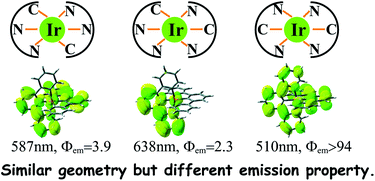We report a theoretical study on three tridentate Ir(III) complexes for organic light-emitting diode (OLED) applications. The geometries, electronic structures, emission properties, and quantum efficiencies of these Ir(III) complexes [(C^N^N)Ir(III)(C^N^N)]+ (denoted as 1 hereafter), [(C^N^N)Ir(III)(N^C^N)]+ (2), and [(N^C^N)Ir(III)(N^C^N)]+ (3) were investigated theoretically, where C^N^N = 6-phenyl-2,2′-bipyridine, N^C^N = 2,6-pyridyl-benzene. The ground- and excited-state geometries were optimized at the PBE0/LanL2DZ;6-31G* and uPBE0/LanL2DZ;6-31G* level of theory, respectively, within acetonitrile solvent simulated by PCM. The emission bands and singlet–triplet transition properties of 1 and 2 are well reproduced with TD-PBE0//Stuttgart;cc-pVTZ;cc-pVDZ level of theory. The quantum efficiencies of 1 and 2 that were obtained upon metallic character analysis are comparable with the observed efficiencies. The metallic character analysis also revealed that the theoretically designed isomer 3 would highly phosphorescent at 510 nm.

You have access to this article
 Please wait while we load your content...
Something went wrong. Try again?
Please wait while we load your content...
Something went wrong. Try again?


 Please wait while we load your content...
Please wait while we load your content...